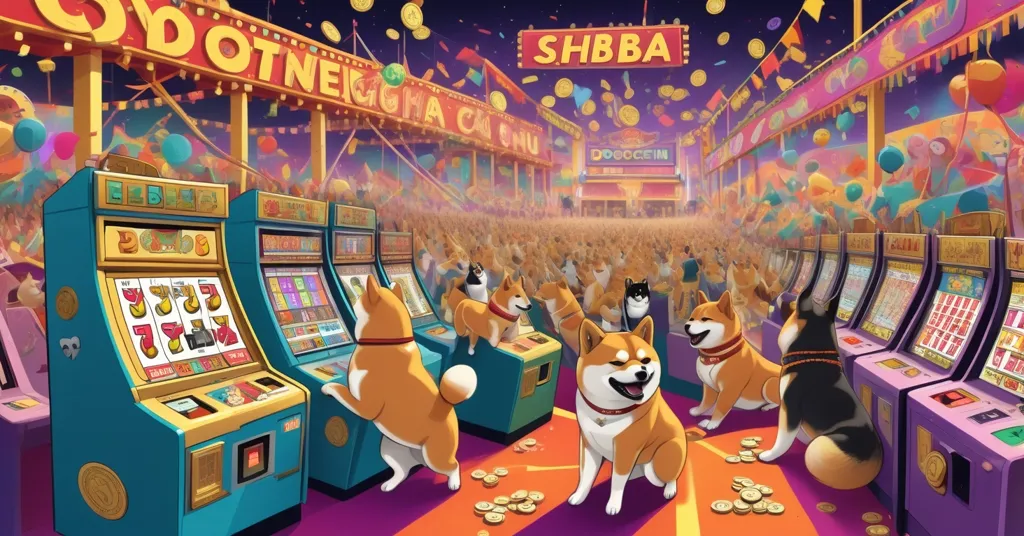Meme Coin Hype: Can Shiba Inu, Dogecoin, or Layer Brett Deliver 100x Returns by 2026?

Meme Coin Madness: Can Shiba Inu, Dogecoin, or Layer Brett Turn $100 into $10,000 by 2026?
Meme coins are back in the spotlight, promising life-changing returns with just a small bet. We’re taking a hard look at three players—Shiba Inu (SHIB), Dogecoin (DOGE), and the newcomer Layer Brett ($LBRETT)—to see if a $100 investment could realistically hit $10,000 by 2026, or if this is just another round of hype from crypto’s wild west.
- Shiba Inu (SHIB): Legendary past gains, but a 100x now looks like a fever dream with its massive market cap.
- Dogecoin (DOGE): The original meme coin with cultural staying power, yet capped by weak price mechanics without viral sparks.
- Layer Brett ($LBRETT): A fresh face with bold tech claims and 100x potential—genuine innovation or slick marketing?
Why Meme Coins Matter (and Why They Don’t)
Meme coins are the crypto world’s guilty pleasure—part circus, part lottery ticket. They’ve onboarded millions of new users with their low entry barriers and viral appeal, often acting as a gateway to deeper blockchain exploration. But let’s not sugarcoat it: most are speculative bubbles, driven by community hype rather than substance, and they can distract from the real mission of decentralization and financial freedom that Bitcoin embodies. Still, they’re a piece of the puzzle, testing the limits of community-driven value and sometimes even pushing tech boundaries. So, let’s break down these three contenders with a clear head and a sharp eye for bullshit.
Shiba Inu: Fading Glory or Hidden Spark?
Shiba Inu exploded in 2021, turning tiny investments into millions for early adopters who rode the wave of pure FOMO (Fear of Missing Out—a term for the panic of missing a hot opportunity). It was the ultimate underdog story, fueled by a passionate community and a bull market that lifted all boats. Now, with a market cap in the billions, the numbers are sobering. Market cap, for the uninitiated, is the total value of all tokens in circulation. For SHIB to jump 100x from here—turning your $100 into $10,000—it would need an influx of capital larger than the GDP of some countries. That’s not optimism; that’s delusion.
SHIB isn’t standing still, though. They’ve rolled out Shibarium, a Layer 2 solution—think of it as a side network built on top of the main blockchain to make transactions faster and cheaper. They’re also burning tokens, a process of permanently removing coins from circulation to reduce supply and, in theory, boost price. But the burn rate is a slow crawl, and Shibarium’s adoption stats are murky at best. Without hard data showing real traction, this feels more like PR than game-changing progress. A 10x gain might be on the table if the market goes nuts again, but expecting more is like betting on a unicorn sighting. As Bitcoin purists, we have to ask: does SHIB even align with the ethos of sound money, or is it just a shiny distraction?
Playing devil’s advocate for a moment, what if SHIB’s burns accelerate massively—say, 50% of supply gets torched—and Shibarium becomes a go-to for cheap DeFi plays? A perfect storm could reignite the hype. But without transparency on burns or user growth, we’re not holding our breath. The glory days might be just that—history. If you’re curious about speculative forecasts on SHIB’s potential, check out this detailed analysis on Shiba Inu’s price outlook compared to other meme coins.
Dogecoin: Cultural Giant, Mechanical Dwarf
Dogecoin, born as a 2013 joke, somehow became the king of meme coins. Its Shiba Inu mascot and absurd origins captured hearts, and viral moments—often tied to celebrity tweets—sent its price soaring at times. DOGE has “brand recognition” that most altcoins can only dream of, with a community that clings to it like a family heirloom. “Diamond hands,” a slang term for holding through price dips, defines DOGE holders. But sentiment alone doesn’t pay the bills.
Unlike Bitcoin’s capped supply or SHIB’s burn attempts, DOGE lacks any real mechanism to drive scarcity. Its inflationary design means more coins keep entering circulation, diluting value over time unless demand skyrockets. Past pumps, often fueled by social media buzz, have been short-lived, fizzling out as quickly as they ignited. For a $100 investment to hit $10,000 by 2026, DOGE would need a 100x surge, pushing its market cap into the stratosphere. A 3-5x feels more grounded, but even that hinges on another internet-breaking meme moment. Without it, DOGE is more nostalgia than investment thesis.
Let’s entertain the flip side: what if DOGE gets adopted as a legit payment method by a major platform, or a cultural shift makes it the internet’s default tip currency? Unlikely, given its clunky tech compared to modern blockchains, but stranger things have happened in crypto. Still, we’re skeptical—DOGE’s charm is its curse, keeping it more meme than money.
Layer Brett: Tech Darling or Hype Trap?
Layer Brett ($LBRETT) is the shiny new toy in the meme coin sandbox, priced at just $0.0058 during presale. It’s pitching itself as more than a joke, claiming to be a Layer 2 network—a secondary blockchain layer that boosts speed and cuts costs on top of a primary chain. With a reported 10,000 transactions per second (TPS, a measure of how many trades a network can handle) and gas fees of just $0.001 (the cost to process transactions, a notorious pain point on busy chains like Ethereum), $LBRETT is gunning for scalability that older meme coins can’t touch.
Then there’s the eye-popping 610% APY (Annual Percentage Yield, the yearly return on staked tokens) for staking—locking up your coins to support the network and earn rewards. Add NFT (non-fungible tokens, unique digital assets) and DeFi (decentralized finance, financial tools without banks) integrations, and Layer Brett looks like a meme coin with actual utility. Analysts are hyping a 100x jump from presale, turning $100 into $10,000 by 2026. Sounds dreamy, right? But hold up—yields that high often scream “too good to be true,” hinting at unsustainable tokenomics or outright scams. Established DeFi projects typically offer 5-20% APY, not triple-digit fantasy land. Is this innovation, or a neon sign for a rug pull?
On the other hand, if Layer Brett’s tech delivers, it could carve a niche for low-cost, high-speed meme transactions—something Bitcoin doesn’t prioritize and Ethereum struggles with during peak demand. As fans of effective accelerationism, we’re rooting for disruptive ideas, but unproven projects like this are a gamble. For every early SHIB winner, there are countless bagholders burned by flashy promises. Tread lightly.
Historical Lessons: Meme Mania’s Boom and Bust
Meme coins aren’t new. Dogecoin’s 2013 rise showed the power of internet culture in finance, while SHIB’s 2021 moonshot proved small bets could yield absurd returns in a bull market. But for every success, there are graveyards of failed tokens—projects with anonymous teams, locked liquidity, or roadmaps that vanish overnight. These “rug pulls” are scams where developers hype a coin, then disappear with investor funds. Red flags include unrealistically high returns, no transparency, or hype over utility. The lesson? Early-stage tokens might offer outsized gains, but most flop or fleece you. Layer Brett’s in that risky “ignition phase”—it could ignite, or it could explode in your face.
2026 Outlook: Market Winds and Regulatory Shadows
Looking to 2026, meme coin fortunes will hinge on broader crypto trends. If Bitcoin dominance spikes, altcoins—including memes—could bleed value as capital flows to the king. Conversely, an “altcoin season” (a period where smaller coins outperform BTC) could lift SHIB, DOGE, and $LBRETT. Regulation looms large, too. Meme coins often draw scrutiny for market manipulation or investor harm, and a crackdown by governments could tank speculative plays. A $100-to-$10,000 dream assumes a friendly market with no legal roadblocks—a big if. Factor in volatility, and you’re not investing; you’re rolling dice.
Meme Coins vs. The Bigger Picture
As Bitcoin maximalists, we can’t ignore that meme coins often dilute focus from blockchain’s true potential: censorship-resistant money and personal sovereignty. Bitcoin is the bedrock of decentralization, while Ethereum and others innovate with smart contracts. Meme coins? They’re often sideshows, onboarding curious newbies at best, scamming them at worst. Yet, we’re not blind to their role. Projects like Layer Brett, if legit, test scalability and low-cost tech that could indirectly benefit the ecosystem. Even failures teach lessons about community dynamics and tokenomics. But let’s be blunt—chasing meme coin riches is a detour from the revolution we’re fighting for. If you’re playing this game, keep it a small side bet, not your war chest.
Key Questions and Takeaways on Meme Coin Investments
- Can Shiba Inu Turn a $100 Investment into $10,000 by 2026?
Highly unlikely. SHIB’s bloated market cap means a 100x gain requires trillions in fresh capital—a fantasy. Even with Shibarium and burns, 10x feels like the realistic limit. - Is Dogecoin Still a Viable Bet for Massive Returns by 2026?
Doubtful without a viral miracle. DOGE’s cultural weight is huge, but its inflationary supply caps upside at 3-5x unless another internet frenzy hits. - Does Layer Brett’s Blockchain Tech Make It a Standout Meme Coin?
Maybe, if it’s real. Boasting 10,000 TPS, $0.001 gas fees, and 610% APY staking, $LBRETT claims utility. But unproven tokens often hide scams behind big numbers—extreme caution needed. - Are Meme Coins a Legitimate Path to Wealth in Today’s Crypto Market?
Seldom. Early projects like Layer Brett might reward risk-takers, but SHIB and DOGE are past peak growth phases, and most meme coins crash or con investors. - How Do Meme Coins Fit Into Bitcoin’s Decentralization Mission?
They’re a double-edged sword. Often distractions from Bitcoin’s financial freedom goal, they can also onboard users and test blockchain ideas, indirectly aiding the broader fight for decentralization.
Meme coin mania is a high-stakes carnival—thrilling, chaotic, and often ruthless. We’re all for pushing tech and adoption at warp speed, but not at the cost of peddling false hope or ignoring fundamentals. SHIB and DOGE have had their spotlight; Layer Brett might be next, or it might be nothing. If you’re tossing $100 at these lottery tickets, know the odds are stacked against you. Keep your focus on the real game—building a decentralized future with Bitcoin at the helm. Anything less is just noise.



